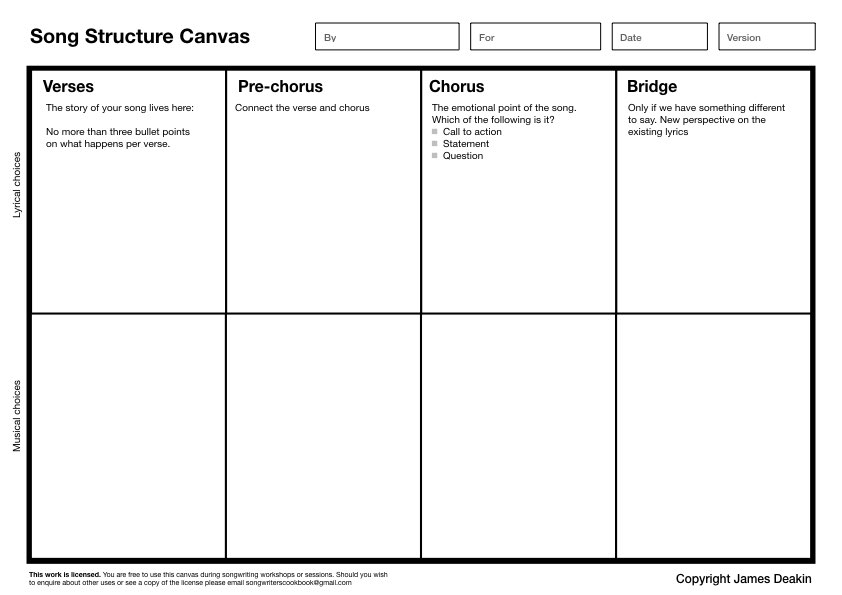song layout
Plan your song's structure
The challenge
Song forms
There are lots of different ways to structure a song. As with every other decision in song writing the only “correct” choice is the one that fulfils your artistic goal. If you want to dive deeper you can read more about your options here.
For this recipe however, we are going to focus on the most commonly used structure in contemporary EDM, pop, rock, funk, disco, reggae and Soul.
- Intro (4bars) – optional
- Verse 1 (16 bars)
- Pre-chorus (4 bars)
- Chorus (8 bars)
- Verse 2 (8 bars)
- Pre-chorus (4 bars)
- Chorus (8 bars)
- Bridge (optional)
- Chorus (8 bars)
- Chorus (8 bars)
- Outro (4 bars) – optional
There are many decisions that must be made about each section and how they come together to form the song. Each decision must be made with your creative intent in mind.
The role of each section
Assembling a section of a song brings many things together. Rhythm, melody and harmony all play a role as well as rhyme, meter and structure. Knowing what each section is trying to achieve makes the job a little easier.
Verses
The verses are the sections of the song where you tell the majority of the songs story. Most of the content lives here. Remember brevity and natural, conversational language helps songs connect with their audience. This is the place where you use sensory words to “show not tell” the listener what is happening and help them feel what you intend them to feel.
Pre-chorus
This provides a link between the verse and the chorus. If often set’s up the chorus sometimes building tension that the chorus will release. Lyrically it’s often a way to connect to the repeated message in the refrain. Sometime this is done using linking words such as “but” or “and”.
Chorus
This is the main emotional point of the song.
It typically uses repetition to drive the message home. Look up the words to songs you like, note how often the chorus message is repeated. There are different types of repetition used including but not limited to:
- Sandwich repetition – the main message starts and ends the chorus wrapping up anything that’s in the middle
- Internal repetition – Repetition inside a line itself e.g. If we sing “what do you care” and then repeat “do you care, do you care, do you care”
- Complete repetition – the chorus says the same thing over and over. This is taken to an extreme by Daft Punk. The lyrics of their song “Around the world” are simply the phrase “Around the world” repeated 144 times.
Chorus message forms
Choruses are usually one of the following:
- Call to action – “Get into the groove”
- Statement – “I Wanna Dance With Somebody”
- Question – “Do you really want to hurt me”
If your chorus isn’t one of these three, ask yourself why.
Bridge
You should only use a bridge if you need one. It’s a place where you put new lyrical content. It should be tangential to the rest of the song. Sometimes a bridge will re-frame the rest of the content making you change your view of the rest of the lyrics. In contemporary music the bridge is a place to bring in new musical ideas as well preventing the song from becoming too repetitive.
Song Structure canvas
Assembling a section of a song brings many things together. Rhythm, melody and harmony all play a role as well as rhyme, meter and structure. Make life a little easier using our Song Structure Canvas. Creating a reference for what you want each section to achieve is surprisingly helpful. It looks like the image below.
1. Download the Song Structure Canvas
Click here to get the Song Structure canvas.
2. Print it out
3. Sketch out the song
Don’t try to write lyrics just yet. Draw on the ideas you have developed and In the verses, bridge and pre-chorus put in bullet points describing the rough shape of the song. Put a line in each section similar to the below:
- Verse 1: I’m alone but I’m happy
- Pre-chorus: but now I’ve met you
- Chorus: I can’t do without you
- Verse 2: why is everything different now?
- Pre-chorus 2: but the more I know about you
- Chorus: I can’t do without you
- Bridge: Do you need me as much as I need you, I hope you do because
- Chorus: I can’t do without you
4. Add high level story ideas
In the verses add no more than three bullets on the narrative ideas you develop.
5. Plan your chorus
Decide if it will take the form of a call to action, statement or question. You might wish to see how your song changes if you switch from one form to another.
6. Pause on the musical choices
Read the rest of the song writing method before you fill in the bottom boxes. The sections on how to write music and how to create contrast between sections will tell you how to fill in those sections.
